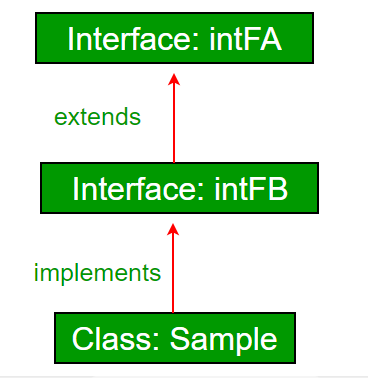
Please refer Multiple inheritance in java for more. In interfaces, a class can implement more than one interface which can’t be done through extends keyword. Let's say you're creating an interface for a bakery, which all baked goods should implement.I have made a game using Java, my game is a state based game, so it extends StateBasedGame, I want to put the game on a website which will require me to make it an applet (unless there is another way) so it must also extend JApplet, after trying to extend multiple class's and reading online I had no luck and read on a forum post that it is not possible to have multiple extends. Java does not support multiple inheritances but we can achieve the effect of multiple inheritances using interfaces. To declare an interface, you'll need to use the interface keyword, followed by the interface name. Just follow the rules, and you'll be the life of the party. The syntax for declaring an interface in Java is quite formal, but don't let that intimidate you.
#Java interface multiple extends code#
If declaring an interface were an event, it would be a black-tie affair, with a strict dress code and a well-defined guest list. This makes your code more modular, maintainable, and extensible, allowing you to easily swap out one implementation for another without causing chaos. Java avoids the multiple inheritance problem for classes by allowing a class to extend only one other class. In Java, interfaces serve a similar purpose, ensuring that different classes adhere to a common set of rules and guidelines.

How do you ensure that each team's work aligns with the overall project? You provide them with detailed blueprints and guidelines, of course. You have several teams of workers, each with its own set of skills, like electricians, plumbers, and carpenters. To understand the value of interfaces, picture yourself as a project manager overseeing the construction of a skyscraper. The Role Of Interfaces In Java: A Real-Life Analogy While a class can inherit from only one superclass, it can implement multiple interfaces, making it the ultimate multitasker. Classes, on the other hand, can be instantiated and may contain both concrete (implemented) methods and abstract methods (if declared abstract). It acts as a blueprint, setting the stage for classes to fill in the details. FeatureĪn interface, unlike a class, cannot be instantiated. While they share some similarities, there are key differences that set them apart.

Interface vs Class: The Ultimate Showdownĭistinguishing between an interface and a class can feel like trying to spot the difference between two nearly identical twins. Think of interfaces as the scaffolding upon which you construct the magnificent edifice of your code. These methods serve as a blueprint, outlining the structure and behavior that classes must follow when implementing the interface. In technical terms, an interface is a collection of abstract methods that can be implemented by any class. An interface is like a contract that dictates the rules and guidelines for composing that music, ensuring every band member (class) plays in harmony. Imagine you're a rock star programmer (which you undoubtedly are), and your code is the sweet music you create. Let's kick off our journey into the world of Java interfaces by likening them to contract negotiations. For more information, read our affiliate disclosure. If you click an affiliate link and subsequently make a purchase, we will earn a small commission at no additional cost to you (you pay nothing extra). Important disclosure: we're proud affiliates of some tools mentioned in this guide. The extends keyword is used once, and the parent interfaces are declared in a comma-separated list. Interfaces are not classes, however, and an interface can extend more than one parent interface. Real-World Examples Of Using Java Interfaces: Welcome To InterfaceLand! A Java class can only extend one parent class.Best Practices For Designing Interfaces: A Five-Star Recipe For Success.And, in generic type bounds, you use extends regardless of whether its an interface or a class.
 'class AandBList
'class AandBList
In this guide, we'll embark on a thrilling adventure to unravel the mysteries of Java interfaces. That's where interfaces come in, the unsung heroes of the Java world, often overlooked but packing a powerful punch. You've got a solid grasp on the basics, but you're itching to dive deeper and explore the hidden treasures Java has to offer. Picture this: you're a Java developer on a mission to conquer the world of programming, one line of code at a time.


 0 kommentar(er)
0 kommentar(er)
